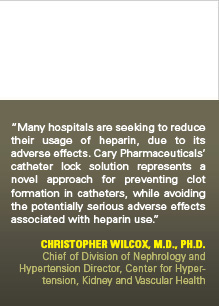![]()
![]()
It is estimated that over 250 million peripheral and central catheters are used each year in clinical medicine. Considering a conservative treatment regimen, a cumulative total of 900 million heparin locks are administered each year. Peripheral and central catheters are used in the hospital setting to provide an access site to the patient's veins to administer intermittent medications, intravenous (IV) fluids, and draw blood samples. In order to maintain the patency (free of blood clots) of the catheter tip, a solution containing heparin (10-100 IU) is often used to "lock" the catheter when it is not in use, which is intended to prevent the catheter from clotting. However, as many as 15% of all access sites continue to be lost due to catheter blockage.
Heparin has been associated with serious side effects such as heparin-induced thrombocytopenia (HIT). As with many drugs, overdoses of heparin can be fatal. In September 2006, heparin received worldwide publicity when three prematurely-born infants died after they were mistakenly given overdoses of heparin at an Indianapolis hospital.
A catheter lock solution that does not contain heparin could provide hospitals with an effective new treatment alternative for preventing clot formation in catheters, without the serious side effects associated with heparin.
Cary Pharmaceuticals Inc.
9903 Windy Hollow Road
Great Falls, Virginia 22066
Phone: (703) 759-7460
info@carypharma.com



